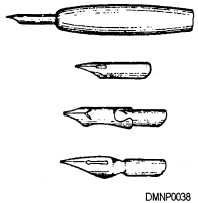Pen and Inks
Introduction
Pen nibs and reservoir pens are made by many different manufacturers and in
a variety of styles. Proper care and correct use can prolong the useful life of
pen nibs and reservoir pens. For extended study of pen and ink drawing,
review the works of M. C. Escher and Edvard Munch.
Pen nibs
Pen nibs detach from handles or drawing instruments. There are drawing
nibs and lettering nibs. After you select an appropriate pen nib, make sure
the nib is clean. If a nib has not been used before, moisten it slightly to
remove the manufacturer’s protective oils. Do not fill a pen nib more than
3/8 inch up the nib blade. This prevents the nib from bleeding on the paper
surface.
Drawing nibs
In general, nibs used for drawing have more spring than lettering nibs. Like
a pencil, varying the width of the stroke creates a line that is more sensitive
and interesting. Some nibs are so stiff that excessive pressure gouges the
paper surface by disturbing the fibers. Torn fibers absorb the ink giving
lines a fuzzy appearance. Other nibs have more spring that allows you to
vary line width. Quill-nibbed pens produce an extremely fine line and are
very responsive.
Figure 1-18 shows quill pen nibs.
Figure 1-18.—Quill pen nibs.
Continued on next page
1-31

